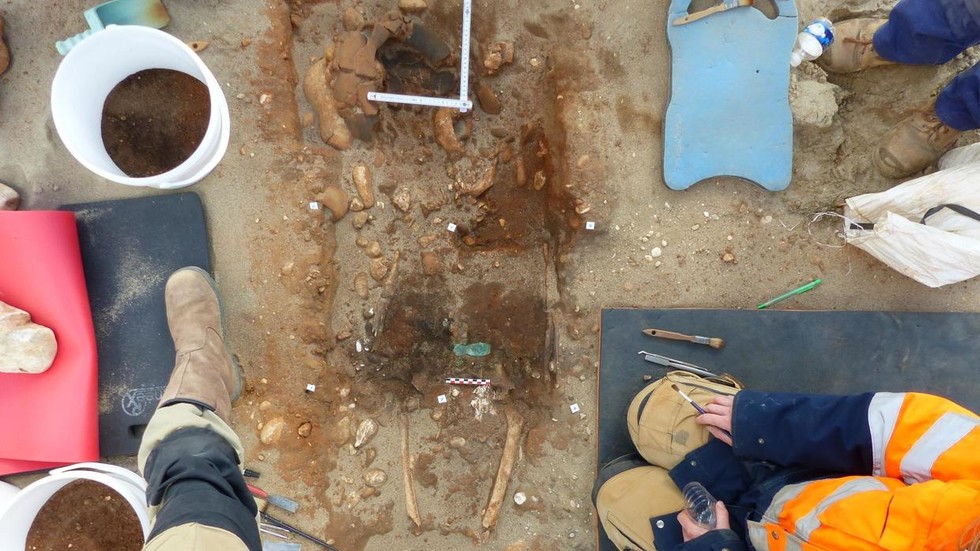Twenty miles from Lyon in France, in preparation for construction work, a real “princess” was unearthed, although it refers to the Iron Age. So, closer to the point. Workers stumbled upon a grave that is 2800 years old. She belonged to the representative of the fair sex, who lived in the 8th century BC.
The media dubbed her the “princess” because of the jewels that she was wearing when she was buried. Her high social status is beyond doubt. The lady was buried in an oak coffin, which was the prerogative of the upper class. Her arms were spread out to the sides, jewelry was present on her neck.
The dimensions of the tomb were 8.5 feet by 3.5 feet.
The wrists were decorated with rings of blue and blue-green glass, interwoven with threads of light shades. Glass beads alternated with copper. A woman wore a belt with a buckle made of the same metal. The belt itself was made, most likely, of leather, which rotted over time.
Given the technology of the time, glass products were rare and difficult to manufacture, which is a sure sign of wealth and buried status. Next to it, in addition to the products we mentioned, there are small slides of plates made of material similar to pearls.
The tomb of the “princess” was one of the three found graves belonging to the same period. The other two were a little later, dating back to about the fifth century BC. The remains located in them were most likely cremated. Other graves were marked by four pillars and surrounded by a shallow moat.
The plot is divided in half. In one half was a wooden box lined with limestone, in which washed bones and fragments of bracelets were stored. In the other, bones and charcoal from a funeral pyre. It’s difficult to determine by whom they belonged, but copper bracelets and an iron hairpin on the belt indicate that the remains belong to another woman.
Buried in tombs belonged to Hallstatt culture, a civilization that existed in the early Iron Age, between 800 and 450 BC and spread throughout Central Europe. It was distinguished by developed agriculture and interesting monuments.
Civilization has developed out of several tribes that are independent of each other, have no political relations, but are united by trade interests, exchanging a variety of goods, from household items to agricultural implements. Until the Mediterranean Sea, there was trade in metal: tin, copper, iron.







Customer
Thanks for sharing. I read many of your blog posts, cool, your blog is very good. https://accounts.binance.com/it/register-person?ref=P9L9FQKY
Customer
Thank you for your sharing. I am worried that I lack creative ideas. It is your article that makes me full of hope. Thank you. But, I have a question, can you help me?
Customer
Thanks for sharing. I read many of your blog posts, cool, your blog is very good.
Customer
Can you be more specific about the content of your article? After reading it, I still have some doubts. Hope you can help me.
Customer
Can you be more specific about the content of your article? After reading it, I still have some doubts. Hope you can help me.
Customer
Can you be more specific about the content of your article? After reading it, I still have some doubts. Hope you can help me.
Customer
I don’t think the title of your article matches the content lol. Just kidding, mainly because I had some doubts after reading the article.
Customer
Your point of view caught my eye and was very interesting. Thanks. I have a question for you.
Customer
Your article helped me a lot, is there any more related content? Thanks!
Customer
Your article helped me a lot, is there any more related content? Thanks!
Customer
Thank you for your sharing. I am worried that I lack creative ideas. It is your article that makes me full of hope. Thank you. But, I have a question, can you help me?
Customer
Thank you for your sharing. I am worried that I lack creative ideas. It is your article that makes me full of hope. Thank you. But, I have a question, can you help me? https://accounts.binance.com/ES_la/register?ref=T7KCZASX
Customer
Can you be more specific about the content of your article? After reading it, I still have some doubts. Hope you can help me.
Customer
Your article helped me a lot, is there any more related content? Thanks!
Customer
Thank you for your sharing. I am worried that I lack creative ideas. It is your article that makes me full of hope. Thank you. But, I have a question, can you help me?
Customer
I don’t think the title of your article matches the content lol. Just kidding, mainly because I had some doubts after reading the article.
Customer
Your article helped me a lot, is there any more related content? Thanks! https://accounts.binance.com/bg/register?ref=V2H9AFPY
Customer
I don’t think the title of your article matches the content lol. Just kidding, mainly because I had some doubts after reading the article.
Customer
Your point of view caught my eye and was very interesting. Thanks. I have a question for you.